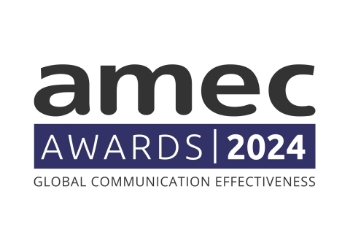A guide to your studies with AMEC International Certificate in Measurement and Evaluation
Course Handbook
WELCOME – to the AMEC International Certificate in Measurement and Evaluation.
AMEC (the International Association for Measurement and Evaluation of Communication) is the leading global trade body for companies and practitioners specializing in communications research, measurement, and analytics. What we do is “set the standard” for best practice and new ways of working. AMEC has more than 200 global organisations in membership in over 100 countries.
AMEC has made a strategic commitment to knowledge sharing and provides industry education and resources. The AMEC Knowledge Share website captures outstanding papers from leaders from around the world, gold award winning case studies and tools for communications effectiveness. Our unique video library lets you watch presentations at AMEC events by top international experts. Further information can be found at www.amecorg.com
The AMEC International Certificate Course in Measurement and Evaluation is being delivered on our behalf by our training partner, PR Academy. However, if at any time you wish to contact AMEC, please do not hesitate to contact Julie Wilkinson – details are listed below.
Johna Burke
AMEC Global Managing Director
M: +1 (602) 319-6726
Julie Wilkinson
AMEC Executive and Member Manager
M: +44 (776) 525-1393
E: juliewilkinson@amecorg.com
W: https://amecorg.com/
Course overview
About the course
- The course is really flexible and is delivered through a mix of on-demand content, tutor support and a live interactive workshop (repeated quarterly).
- Typical time to complete the course is about four months, but you have a year to complete it.
- The course is run for AMEC by PR Academy, through PR Academy’s online learning centre which includes an online library with access to key texts including “Evaluating Public Relations” published by Kogan Page.
- The course includes extensive use of case studies and provides the latest thinking on relevant metrics and tools.
- All necessary materials and resources are provided in the course fee.
- The course is assessed through a practical work-based assignment and on completion AMEC will awards students an electronic Certificate with the awarded grade, which will be sent shortly after the assignment marking period is complete.
What level is it taught at?
This course is taught at first-degree level.
How will I be assessed?
The assessment is a 2000-word assignment comprising an evaluation report and supporting tools. On successful completion of the assignment, you will receive the AMEC International Certificate in Measurement and Evaluation.
Does it matter where I am based?
No, you can study from anywhere in the world at a time and pace that suits you.
How many hours a week should I devote to study?
It depends how quickly you want to complete the course. For example, if aiming to complete it in about four months, then around four hours a week is about right – although more time may be needed when you are working on your assignment.
Your course director: Thomas Stoeckle
Thomas is a former managing director of Report International (now part of CARMA) and has held senior roles at WCG and LexisNexis Global Media Intelligence. He is now an analytics and insights partner at life sciences communication agency Dot I/O Health. He is a member of AMEC, a doctoral researcher and lecturer at Bournemouth University, and a Fellow of Advance HE, the UK’s Higher Education Academy. Thomas is also the co-founder and co-host of www.smalldataforum.com, a monthly podcast on the uses and abuses of data big and small in media, politics, and public life (you will not get graded on it, but it is recommended listening!).
About online learning
The course is run over PR Academy’s Study Hub. This bespoke online platform has easy to follow lessons, video, podcasts and guided reading. Learners have access to an extensive online library. It is the gateway to all your learning resources and activities for the AMEC Certificate course.
Interactive workshops
Live online, case-study based interactive workshops are held quarterly. You can book on to the one that works best for you. Full details are available on the course pages.
Assignment deadlines
There are four times a year when you have the opportunity to submit an assignment. Dates will be shown on your course but as a guide are typically in:
- March
- June
- September
- December
Syllabus
Taught at degree level and designed to take about four months, the AMEC International Certificate in Measurement and Evaluation introduces the history and principles of communications evaluation, including social media evaluation. Grounded in professional practice, it covers essential points about measurement principles, tools, and methods.
The Certificate course is aimed at professionals working in media intelligence firms or PR professionals looking to work more strategically by better understanding the value of analytics and insights to their work.
Outline content
Background and best practice
- Introduction and history
- Barcelona Principles 3.0 and professional practice
- Justifying and applying the AMEC Integrated Evaluation Framework and Measurement Maturity Mapper
Evaluation and strategic planning
- Evaluation’s linkage with planning and research
- Outputs, outtakes and outcomes, process, and impact
- Linking evaluation and objective setting
Research methods primer
- Primary and secondary data
- Quantitative v qualitative
- Introduction to content analysis
An introduction to statistics
- Coding and analysis
- Basic statistical analysis
- Significance and correlations
Traditional media evaluation
- Media evaluation and metrics (ROI, OTS/impressions, and derivatives)
- Content analysis underpinning media evaluation
- A range of metrics and tools for evaluating traditional media.
Social media
- Different approaches to the application of the Barcelona Principles for social media
- Using the PESO model to underpin the evaluation of integrated media.
- A range of metrics and tools for evaluating social media.
Internal communications measurement and metrics
- Fundamental principles of measuring and evaluating internal communication.
- What to measure – outputs and outcomes
- How to measure to seven elements of internal communications
Learning Outcomes
On successful completion of this course, candidates will be able to:
- Understand terms such as evaluation, research, and measurement and their
- Appreciate how to apply research disciplines to measurement and
- Advocate the Barcelona Principles 3.0 and their relevance to communications
- Understand and apply strategic evaluation tools such as AMEC’s Integrated Evaluation Framework and Measurement Maturity Mapper (M3)
- Appreciate research methods and their relevance to
- Build a toolbox of appropriate metrics and appreciate best practice in action.
- Understand those aspects of statistics relevant to communications measurement and evaluation.
- Apply traditional and contemporary thinking and techniques to the monitoring and evaluation of social media, internal communications, and traditional media.
Detailed Content
Background and best practice
- Background to measurement and evaluation from a historical, international and practitioner perspective. AVEs as part of the evolution of evaluation from counting clippings to valid metrics.
- An examination of the contribution that evaluation/measurement can make to the professionalization and credibility of communications, as well as other areas of the
- The Barcelona Principles 3.0 and professional practice: fundamental role of goal setting and measurement, outcomes recommended to only measuring outputs, measure effect on organizational performance, qualitative and quantitative research required, AVEs inappropriate, measure social media consistently with other channels, measurement, and evaluation need research rigor.
Evaluation and strategic planning
- Evaluation as an integral part of communications planning and practice: before, during and after
- Outputs (or process): the immediate product of communications activity that measures efficiency and can generate feedback to fine tune and/or change communications Relatively easy to identify.
- Outcomes (or impact): the ultimate impact – business results – of communications activity that measures effectiveness and provides accountability & credibility. Challenging to measure and isolate
- Distinguishing objectives, goals and
- Objective setting as the fulcrum of effective measurement and evaluation: SMART objectives as an ideal to strive for
- Linking evaluation back to objectives: the hierarchy of objectives and making objectives impact
Research methods primer
- Research and communications: research to scan, research to plan, research to monitor and research to assess
- Secondary data (desk research): already published, can be quick and cheap, but may not be credible or what is
- Primary data (field research): meets precise requirements but can be technical and expensive.
- Quantitative: associated with numbers, statistical analysis, large-scale studies, and researcher detachment
- Qualitative: associated with words, description, small-scale studies, and researcher involvement
- Content analysis: a means of quantifying the content of text in a manner that is clear and has the potential to be
Introduction to statistics
- Hypotheses, sampling, and significance levels
- The five stages of data analysis: data preparation (coding and cataloguing), exploring the data (correlations and themes), analysing the data (statistical tests and concepts), presenting the data (visuals and written findings) and validation (benchmarks and triangulation)
- Issues associated with quantitative and qualitative data basic statistics, cross-tabulation, significance and correlation, independent and dependent variables, content analysis, and conversation
Traditional media evaluation and metrics
- Sourcing content for print, broadcast, and social media, reporting on social media separately and sampling/selecting material; not all sources have the same
- Using content analysis so that media coverage can be classified or coded in such a way that it can be subjected to statistical analysis. Coding parameters and favourability criteria
- Reporting (including commentary and recommendations) on factors such as volume of coverage, impact of specific items of coverage, the presence (or absence) of key messages, tone (beneficial, neutral, adverse)
- Measures of exposure based on, or derived from, OTS/impressions (e.g., cost per contact/impact). Best practice demands that these are balanced with qualitative measures such as tone and message
- Return on investment (ROI): a financial term that measures profit generated against investment made. Alternatively, used to indicate a numerical or evidence-based approach to
- Media evaluation as an outcome-oriented approach to gathering intelligence.
Social media measurement and metrics
- Applying the Barcelona Principles 3.0 to social media measurement
- Monitoring social media: blogs, forums, twitter, Facebook, and cross platform tools & metrics
- The role of human analysis to complement the use of automated social media analysis.
- Social media campaigns addressing a range of objectives from exposure, through engagement, to actions.
- Integrated programmes containing all four PESO elements:
- Paid are social channels you pay to leverage (e.g., promoted tweets or display advertisements)
- Earned is conversation directly resulting from proactive outreach (e.g., bloggers)
- Shared is conversation about the brand (e.g., a retweet)
- Owned are channels you own and control (e.g., website or Facebook page)
Internal communications measurement and metrics
- The CIPR’s Communication Measurement Matrix for the measurement of internal communication combining output and outcome measures.
- Fundamental principles of internal communication measurement
- Channels: are they working?
- Content: are employees getting the information they want and need?
- Conversations: are people communicating effectively?
- Voice: are there adequate opportunities for people to have a say?
- Sentiment: what do employees think and feel about the organisation?
- Behaviour: has employee behaviour been influenced by communication?
- Return on investment (ROI)
- Best practice in research to underpin how to measure internal communications
Strategic Evaluation Tools
- The Integrated Evaluation Framework (IEF) is a professional approach to proving the value of communications and public relations. It is applicable to any organisation, department, agency, or consultancy, customisable to specific campaigns and objectives, and both non-proprietary and free to use.
- IEF is an online tool that enables users to implement the best practice represented by Barcelona 3.0 in a clear step-by-step process.
- The Measurement Maturity Mapper (M3) is a survey-based diagnostic tool that enables practitioners to improve the planning of measurement and evaluation by benchmarking where they are in the monitoring and evaluation process.
- M3 is also rooted in the Barcelona Principles 3.0 and underpinned by the IEF. It helps establish how the organisation concerned undertakes communication measurement on the levels of reporting, planning, and demonstrating impact.
Assessment
The final assessment to obtain your grade is a 2000-word assignment comprising a report on current evaluation practice, supported by strategic evaluation tools. On successful completion of the assignment, the candidate receives an AMEC International Certificate in Measurement and Evaluation.
About PR Academy
PR Academy is possibly the largest provider of PR education in the UK with hundreds of communicators choosing to study with them each year. The team design and deliver a wide range of courses for communicators at all levels, both face to face and online working with top awarding bodies including ourselves, the Chartered Institute of Public Relations (CIPR) and the Public Relations and Communication Association (PRCA).
Contact information
Julie Wilkinson at AMEC: juliewilkinson@amecorg.com
Useful information: deferrals, extensions and resits.
| International Certificate in Measurement and Evaluation |
| I want to…. |
You need to…. |
AMEC will |
PR Academy will…. |
What happens next |
Things to note |
| …defer my assignment or have an extension beyond one year |
…contact your course leader to let them know. Explain the reasons for needing the extension. |
AMEC does not get involved |
…extend the time available to complete the course provided a reason for needing the extension has been provided. |
…you submit the assignment within the new timescale. |
There is no charge or penalty for an extension, but extensions are all granted for one further assignment “cycle” usually about an additional three months. |
| …re-sit my assignment |
…confirm to AMEC that you will submit at the next submission date |
Note on your records. |
…the next submission date will be available on your course page. |
… submit your assignment at the next submission date. |
You can only re-sit an assignment twice.
There is an £85 plus VAT charge for resits payable to PR Academy. |
FAQ and Course overviews can all be answered by downloading the handbook below for all key information:
See the full AMEC Certificate Handbook Here
See the provisional weekly webinar schedule here









